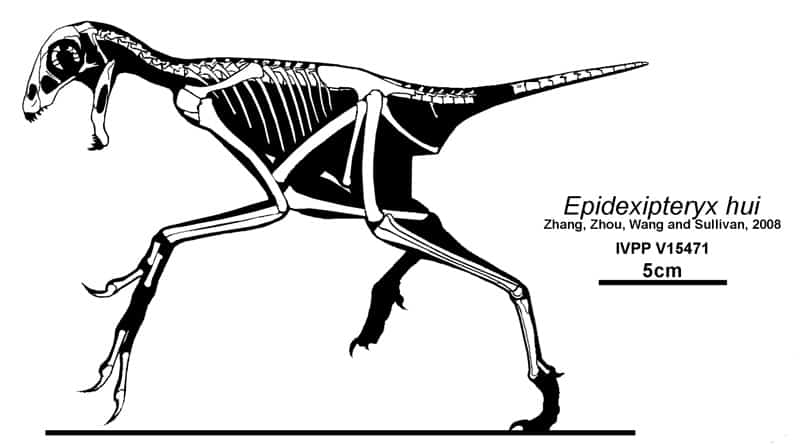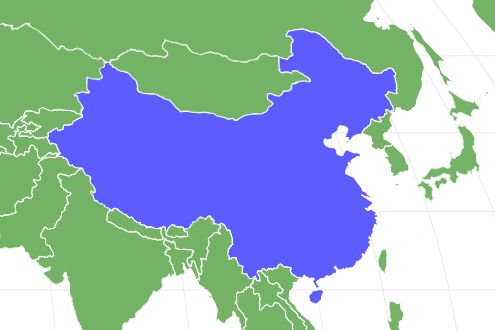Epidexipteryx was one of the smallest non-avian dinosaurs to ever exist.
Advertisement
Epidexipteryx Scientific Classification
- Kingdom
- Animalia
- Phylum
- Chordata
- Family
- Scansoriopterygidae
- Genus
- Epidexipteryx
- Scientific Name
- Epidexipteryx hui
Read our Complete Guide to Classification of Animals.
Epidexipteryx Conservation Status
Epidexipteryx Facts
- Prey
- Insects and worms
- Group Behavior
- Herds
- Fun Fact
- Epidexipteryx was one of the smallest non-avian dinosaurs to ever exist.
- Biggest Threat
- Sinraptor and other relatively large carnivorous dinosaurs
- Most Distinctive Feature
- Tail feathers with four branches
- Distinctive Feature
- Simple body feathers for display and insulation
- Other Name(s)
- Hushi Yaolong (Hu Yaoming's dragon)
- Habitat
- Areas with forests and trees
- Predators
- Larger dinosaurs
- Diet
- Carnivore
- Favorite Food
- Small insects, worms, and larvae
- Type
- Non-avian dinosaur
- Special Features
- Tail feathers
- Origin
- Mongolia, China
- Number Of Species
- 1
- Location
- Inner Mongolia, China
Epidexipteryx Physical Characteristics
- Weight
- 0.36 and 0.49 pounds
- Length
- 9.8 inches
- Venomous
- No
- Aggression
- Medium
View all of the Epidexipteryx images!
Epidexipteryx is a genus of small theropod dinosaurs that lived in the middle to late Jurassic Period. They belong to a group of dinosaurs, also known as paravian dinosaurs or paraves, characterized by enlarged digits held above the ground while walking. They were non-avian dinosaurs and the smallest ones to exist. Epidexipteryx represents the earliest discovered dinosaurs to have ornamental feathers, according to the fossil record.
Description and Size
Only one species of Epidexipteryx is known. The scientific name Epidexipteryx hui translates as “Hu’s display feather” in honor of paleomammologist Hu Yaoming. The dinosaur is also called Hushi Yaolong, which means “Hu Yaoming’s dragon.”
Epidexipteryx was a small dinosaur. In fact, it is the smallest non-avian dinosaur ever found. It was about 9.8 inches in length without the tail and about 17.5 inches if you measure the tail. Estimates of the dinosaur’s weight are between 0.36 and 0.49 pounds.
Only one fossil of this dinosaur has been found so far, and it was found in very good condition, with some of its feathers intact. The fossil is one of the earliest examples of ornamental feathers in the fossil record.
The Epidexipteryx had four long feathers on its tail. The tail feathers were preserved with their vanes and rachis intact. However, these feathers looked different from that of modern-day birds. Instead of the vanes branching into individual filaments, they were made up of a single sheet. The dinosaur also had simpler body feathers made of parallel barbs similar to those present in other primitive, feathered dinosaurs. The feathers were not useful for flight and were mainly for display and insulation. However, these animals probably had some sort of membrane wing that would have made gliding possible.
Epidexipteryx had a short-snouted skull. Teeth were only present in their front jaw, with an unusually long front tooth bent forward. The teeth got smaller towards the back of the skull. One of its unique features was its long digits or fingers, a feature seen in other paravian dinosaurs.

Long digits or fingers, seen in other paravian dinosaurs, was a distinct feature of the
Epidexipteryx.
©Jaime A. Headden_http://qilong.deviantart.com/art/Nitpicker-103918005/CCBY3.0 – License
Diet—What Did Epidexipteryx Eat?
Epidexipteryx’s small size suggests that they only fed on small animals. Their diet would have consisted of small insects, worms, and larvae. The dinosaur also had a distinctive short snout with small dagger-like teeth for catching and eating prey. Based on the structure of their limbs and fingers, scientists have concluded that they were arboreal animals. The long fingers made it easy to climb trees and pick up worms and larvae from tree holes.
Habitat—When and Where Epidexipteryx Lived
Epidexipteryx lived during the Middle Jurassic or Upper Jurassic Period, about 160 to 154 million years ago. Experts found fossils of this dinosaur in present-day Inner Mongolia, China. It lived in areas with widespread forests and trees. Its fingers made it easy to climb and glide down the tree. Epidexipteryx probably lived in a herd, and even though the group would not have been large, it would have served as protection against predators.
Epidexipteryx were not very aggressive but were territorial and extended this overprotectiveness over their females and juveniles. They used the teeth in the front of their jaw to bite their opponent during a fight.
Threats and Predators
The major threat faced by this dinosaur was other carnivorous dinosaurs. Given their relatively small size and limited defenses, they would have quickly fallen prey to bigger animals. Sinraptors were probably one of the Epidexipteryx’s significant predators. However, the small size of this dinosaur and their arboreal nature would have made it possible to evade predators.
Discoveries and Fossils
Scientists have only found one fossil of this dinosaur. The single fossil was found in the Daohugou beds during a collection by the Institute of Vertebrate Paleontology and Paleoanthropology in Beijing.
Extinction—When Did Epidexipteryx Die Out?
Epidexiptteryx died out suddenly during the late Cretaceous period. Scientists are not exactly sure when and how this particular dinosaur went extinct or the factors that led to its disappearance.
Similar Animals to the Epidexipteryx
- Scansoriopteryx — Also known as Epidendrosaurus, the Scansoriopteryx is a bird-like maniraptoran dinosaur native to the Lalong province of China. Its bird-like shape is what differentiates it from the Epidexipteryx. This dinosaur was the first non-avian animal to be classified as an arboreal dinosaur.
- Yi qi — This is a small tree-dwelling dinosaur that lived in China during the middle to late Jurassic period. Its name means strange wing, and it had short feathers which were not useful for flying. However, it was bigger than the Epidexipteryx.
- Sapeornis — This is a genus of avialan dinosaurs that lived during the early Cretaceous. Scientists found fossils of this dinosaur in the western Liaoning province of China.
Related Animals
View all 117 animals that start with EEpidexipteryx FAQs (Frequently Asked Questions)
How many bones did an Epidexipteryx have?
Only a single Epidexipteryx fossil has been found so far, so it is difficult to know the exact number of bones it had. The well-preserved fossil is a partial skeleton, making it hard to speculate on its number of bones.
How big was the Epidexipteryx?
Epidexipteryx is not the smallest dinosaur but the smallest non-avian dinosaur ever found. It was as small as a modern pigeon and weighed about 0.49 pounds.
How did the Epidexipteryx reproduce?
Dinosaurs were oviparous animals with fixed breeding periods. After mating and internal fertilization of eggs, the Epidexipteryx laid the eggs. It would be hatched after the incubation period to produce juveniles and the growing period continued until they became adults. It is possible that Epidexipteryx prepared for breeding like modern birds. It could have made a nest, laid the eggs, and incubated them before hatching.
Where was Epidexipteryx found?
The Epidexipteryx was found in China. Only a single fossil of this dinosaur has been found in the Daohugou formation in the Inner Mongolia area. It lived about 152 to 168 million years ago.
Could Epidexipteryx fly?
No, although they had flight features, the Epidexipteryx could not fly. Experts think they could only glide and move with their feet. The feathers of the Epidexipteryx were only for display and protection.
When was the Epidexipteryx alive?
The Epidexipteryx lived during the middle to late Jurassic Period. This was about 160 to 154 million years ago.
Thank you for reading! Have some feedback for us? Contact the AZ Animals editorial team.
Sources
- BBC Planet, Available here: https://bbcplanetdinosaur.fandom.com/wiki/Epidexipteryx
- Wikipedia, Available here: https://en.wikipedia.org/wiki/Epidexipteryx
- panaves, Available here: https://mpm.panaves.com/nh/epidex.htm
- kid adl, Available here: https://kidadl.com/facts/dinosaurs/epidexipteryx-facts

















